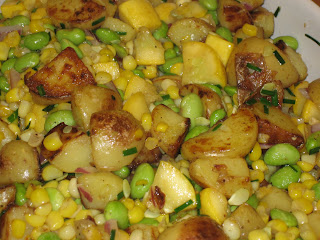 I wanted to be sure to make this recipe before grilling season came to an end. So, a couple of Sundays ago, I woke up early to make my own pizza dough, stashed it away in the fridge, and then headed out with my wife for a nice day of lazing around by my in-laws' pool.
I wanted to be sure to make this recipe before grilling season came to an end. So, a couple of Sundays ago, I woke up early to make my own pizza dough, stashed it away in the fridge, and then headed out with my wife for a nice day of lazing around by my in-laws' pool.We got back home a little later than I expected, and we were hungry. But that was OK, because I had it in my mind that this was going to be quick and easy. And it is, but just not as quick and easy as I thought it was. You see, when I picked this recipe, I didn't actually read it. In the past, when I've had Pizza Margherita in restaurants, it usually involves a thin pizza crust topped with thinly sliced fresh tomatoes and fresh buffalo mozzeralla topped with basil and olive oil.
 I didn't realize that The Book wanted me to peel the tomatoes and simmer them for 10 to 15 minutes. With a hungry, pregnant wife breathing down my neck, and a new episode of Mad Men about to start, every minute counts. I made the executive decision to skip the step of skinning the tomatoes. Foodie purists may sneer at such unabashed corner-cutting, but I don't think that the finished product was harmed by the presence of tomato peels in the sauce.
I didn't realize that The Book wanted me to peel the tomatoes and simmer them for 10 to 15 minutes. With a hungry, pregnant wife breathing down my neck, and a new episode of Mad Men about to start, every minute counts. I made the executive decision to skip the step of skinning the tomatoes. Foodie purists may sneer at such unabashed corner-cutting, but I don't think that the finished product was harmed by the presence of tomato peels in the sauce. After I made the sauce, I was ready to get to pizza-making business. I stretched my two balls of pizza dough into approximately 9-inch rounds, brushed them lightly with oil and laid them on my preheated grill (which had also been oiled). After a few minutes, I flipped the dough and added the sauce and cheese.
After I made the sauce, I was ready to get to pizza-making business. I stretched my two balls of pizza dough into approximately 9-inch rounds, brushed them lightly with oil and laid them on my preheated grill (which had also been oiled). After a few minutes, I flipped the dough and added the sauce and cheese. About the cheese ... for some strange reason, The Book calls for tossing the grated mozzerella with a tablespoon of oil. I can't imagine what purpose this serves (Teena didn't know either). The result was that the topping was very oily. The next time I make this pizza, I'll skip this step.
About the cheese ... for some strange reason, The Book calls for tossing the grated mozzerella with a tablespoon of oil. I can't imagine what purpose this serves (Teena didn't know either). The result was that the topping was very oily. The next time I make this pizza, I'll skip this step.Overall, I was less than impressed with my first attempt at grilled pizza. But I think that it has everything to do with my grill and nothing to do with The Book's recipe (oily cheese notwithstanding). The Book says to grill the pizzas for three to five minutes "until undersides are golden brown and cheese is melted." Well after about 10 minutes, the cheese finally melted, but the undersides never browned. I guess my gas grill just doesn't get hot enough. (It takes forever to cook chicken, too.)
I'll make this pizza again someday ... in the oven, with my pizza stone ... and next time I will peel the tomatoes (are you happy now?). Pizza Margherita is a great example of just how good simple food can be. The sauce, which is nothing more than ripe tomatoes and a little salt and oil, is absolutely delicious.
Date Cooked: August 17, 2008
Degree of Difficulty: Medium
Rating: B-

































